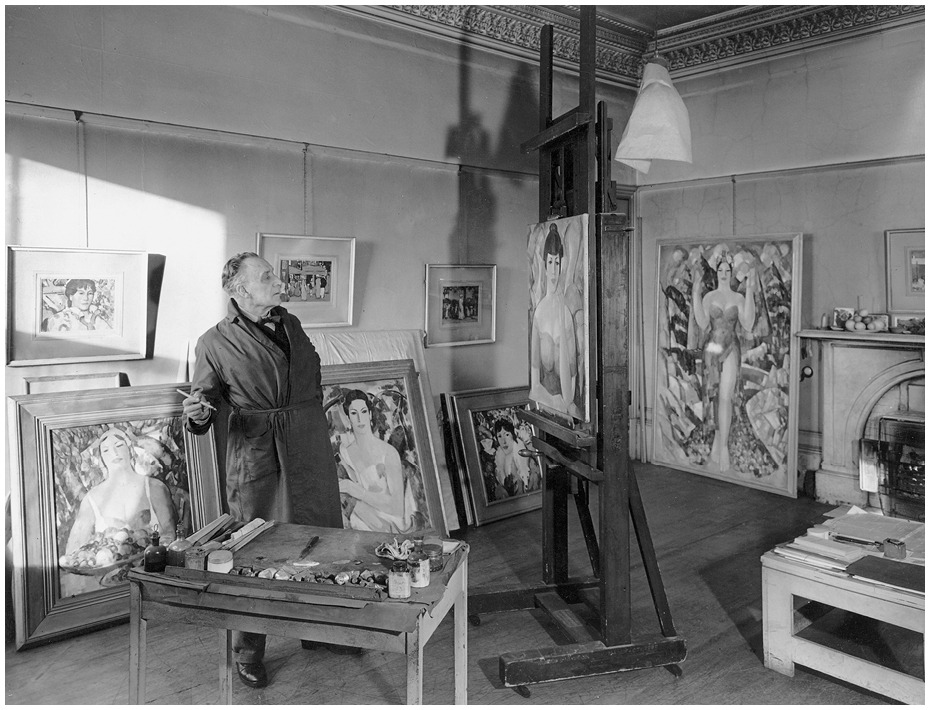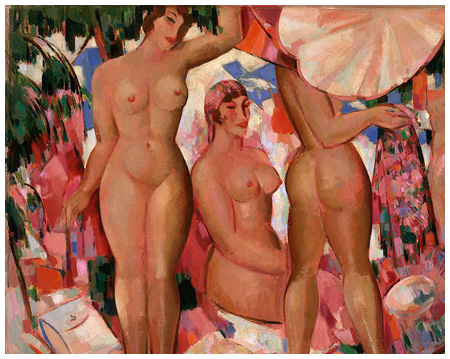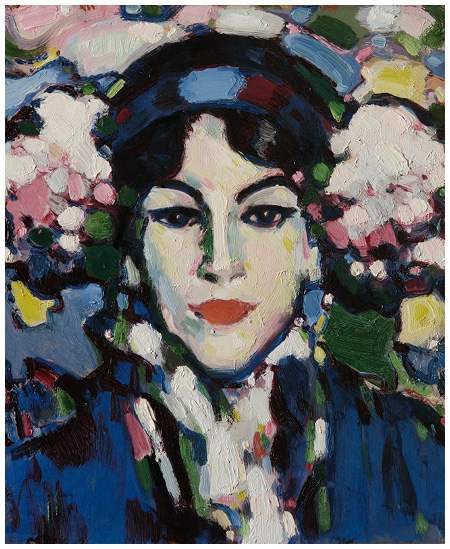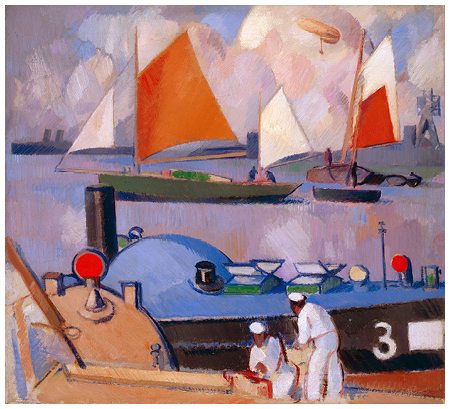Ahead of the first retrospective of his work in more than 40 years, Alice Strang discusses the artwork of the Scottish Colourist and why it has taken so long for us to see it

Who is J. D. Fergusson? You would not be remiss in asking this question as the curator Alice Strang explains, “He’s so well known and revered in Scotland, but so little known down here”. Before this new retrospective he was an artist I’d never been exposed to. But in light of increased public attention on Scotland with discussions of independence a daily presence in British media, it seems only right that one of Scotland’s foremost artists is put under similar scrutiny.
 Above: ‘Bathers: The Parasol’ (1951) Below: ‘Hortensia’ (1922), Blue Submarine: Portsmouth Harbour (1918)
Above: ‘Bathers: The Parasol’ (1951) Below: ‘Hortensia’ (1922), Blue Submarine: Portsmouth Harbour (1918)
Of the four Scottish colourists, J. D. Fergusson (1874-1961) has been described as archetype of this movement. He led an adventurous life at the epicentre of the avant-garde, spending the most formative of his artistic years in Paris and London where he was immersed in the shocking art movements of Cubism and Fauvism. The Pallant House Gallery in Chichester plays host to the first solo exhibition of his work in England for more than forty years, where under the curatorial guidance of Alice Strang, Senior Curator of the Scottish National Gallery of Modern Art, Fergusson’s work is brought out of the shadows south of the border.
I ask her why it has taken this long for a retrospective of his work. “Fergusson didn’t sell much during his lifetime, and now all of that work is in one gallery in Scotland, which means there aren’t many works on the open market”. Unlike colourist contemporaries like Peploe, whose works “went out into the world, they went into collectors homes, they went into museums, they were seen a lot, so his reputation spread so much more during his lifetime and afterwards”.
As an artist Fergusson shied away from commercialism, “It was all about the art”, Strang adds, “if he wanted to, he could have painted flattering portraits of patrons, but he was not materialistic at all”. His work remained in the hands of a small select group, as he refused to compromise on his valuations of his art, “He found a discount an insult” Strang explains.

“If he wanted to, he could have painted flattering portraits of patrons, but he was not materialistic at all”
It is this isolation of Fergusson’s work from general consumption that Strang believes explains a period of disinterest in, or ignorance of, his work for over four decades outside of Scotland.
The enfilade of the Pallent House Gallery maps the chronological development of Fergusson’s career. As rooms, painted to match the colour of Fergusson’s own studio at the time, architecturally flow into one another, it is left to the art to delineate the spaces. Moving through the exhibition, you are transported from Edwardian solemnity, to the bold Parisian colours of the avant-garde, and then abruptly confronted by his radical exposure of the female nude.
Strang describes Fergusson’s glorified female nudes as “celebrations of womanhood, these incredibly strong, physically Amazonian women”. Margret Morris – his long term partner – and her dancers were a continual source a inspiration for Fergusson, their movements and forms recreated in works such as ‘Bathers: Antibes” (1937)
A unique part of Alice Strang’s artistic acquisitions are Fergusson’s sculptures. “The revelation of the exhibition for us has been the sculpture… it turned out that he had been making it for 50 years”. Though intelligently executed, she explains their miniature stature and basic materials were “due to lack of money – he never had a bean. He would carve his models in plaster, and he would exhibit them in plaster, or sometimes he would paint them gold”.
Geography was also integral to Fergusson’s work: “He was from Edwardian Edinburgh, went to pre-First World War Paris, to interwar London, back to Paris and then to Glasgow. He had a long interesting and varied life”. But it was to Glasgow he ultimately returned, immersing himself in the emerging art scene. “He was very supportive of independent art; he disliked establishments like The Royal Glasgow Institute or The Scottish Academy and he didn’t like Glasgow Art Club because they didn’t admit women. He just wanted there to be an affordable way for people to show their work”.
Fergusson’s commitment to Scotland’s artistic development in his latter years mirrors the importance he commands there today. A strong belief Celticism had been growing in him and the resultant isolation of his work in Scotland seems unsurprising. The transportation of Fergusson’s work from its home in Perth, over the border, and down to the south of England marks a unification of the Scottish and English art scene. Alongside a prominent divisory political discourse about independence, this cooperation between Scottish and English galleries to open England’s eyes to this vital contribution to 20th century art is ever more valuable.

“The revelation of the exhibition for us has been the sculpture… it turned out that he had been making it for 50 years”
The Scottish Colourist: J. D. Fergusson is exhibited at the Pallant House Gallery 5 July – 19 October.
All images: © The Fergusson Gallery, Perth & Kinross Council, Scotland




